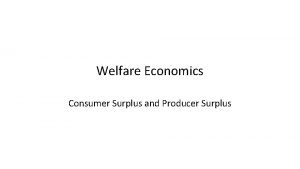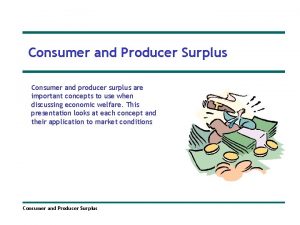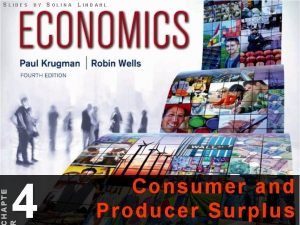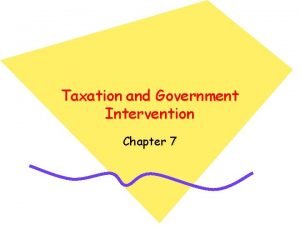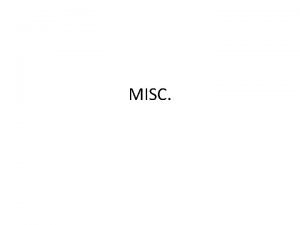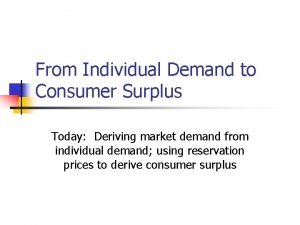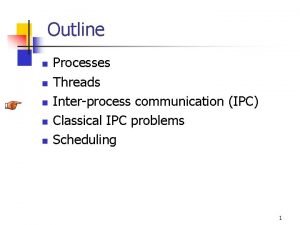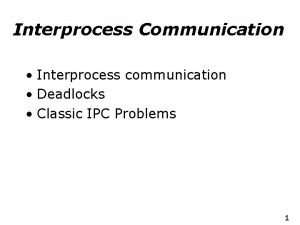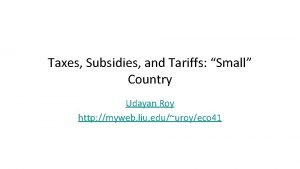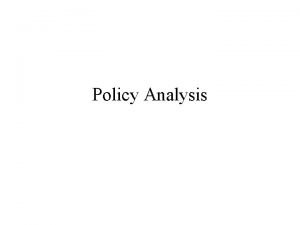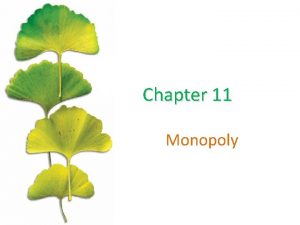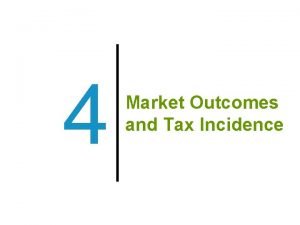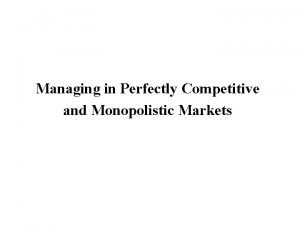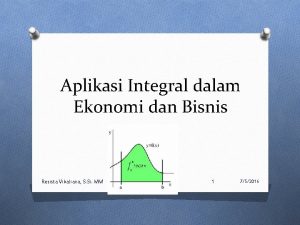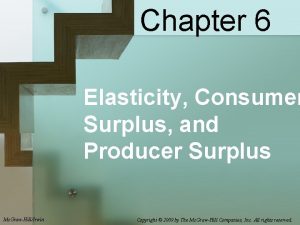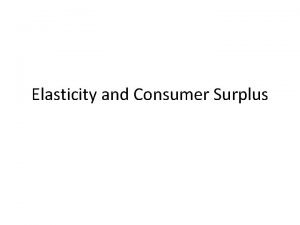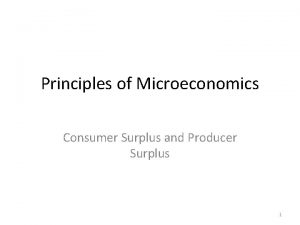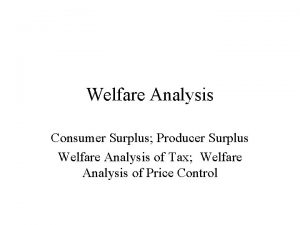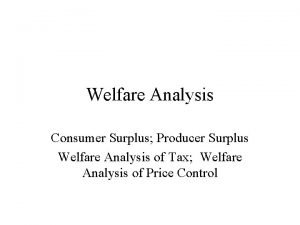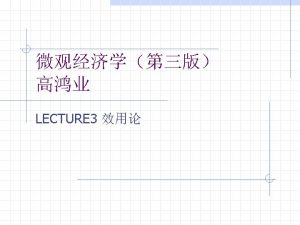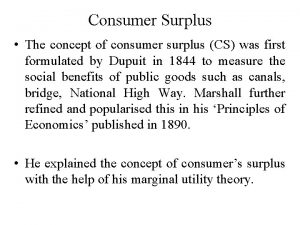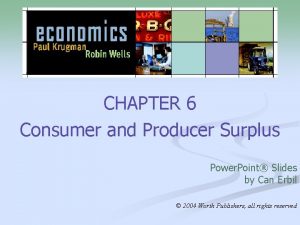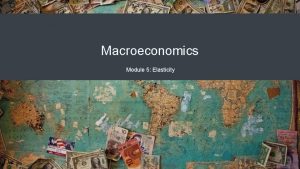Elasticity Consumer Surplus and Producer Surplus Chapter 6











































- Slides: 43

Elasticity, Consumer Surplus, and Producer Surplus Chapter 6 LECTURE 5 & 6 Mc. Graw-Hill/Irwin Copyright © 2009 by The Mc. Graw-Hill Companies, Inc. All rights reserved.

Chapter Objectives • • Price elasticity of demand The total revenue test Price elasticity of supply Cross elasticity of demand Income elasticity of demand Consumer & producer surplus Efficiency losses 6 -2

Price Elasticity of Demand • The responsiveness (or sensitivity) of consumers to a change in a product’s price • Elastic demand ▫ Large change in quantity purchased for given price change • Inelastic demand ▫ Small change in quantity purchased for given price change 6 -3

Price Elasticity of Demand • Price-elasticity coefficient and formula ▫ the degree to which demand is price elastic or inelastic is measured by the coefficient Ed Ed = Percentage Change in Quantity Demanded of Product X Percentage Change in Price of Product X 6 -4

Price Elasticity of Demand • Calculate percentage change • Restate formula Ed = Change in Quantity Demanded of X Original Quantity Demanded of X ÷ Change in Price of X Original Price of X 6 -5

Price Elasticity of Demand • Calculation problem • Starting point matters • Midpoint formula ▫ This formula averages the two prices and the two quantities as the reference points for computing the percentages. Ed = Change in Quantity Sum of Quantities/2 ÷ Change in Price Sum of Prices/2 6 -6

Midpoint formula example • Suppose price increases for a good from $3 to $4 causing the quantity demanded to fall from 20 to 10 units in response to the price change. • Computing the price elasticity coefficient. 10 Ed = (10 + 20) / 2 = 2. 3 ÷ $1 ($ 3 + $ 4) /2

Elimination of the minus sign • Price and quantity demanded are inversely related, hence the price elasticity of demand coefficient will always be negative. • The magnitude (or size) of the coefficient is important. • Economist usually ignore the minus sign and simply present the absolute value of the elasticity coefficient.

Interpretations of Elasticity • Elastic Demand Ed = . 04. 02 =2 • Inelastic Demand Ed = . 01. 02 Ed = . 02 Ed < 1 =. 5 • Unit Elasticity. 02 E d >1 Ed = 1 =1 6 -9

Price Elasticity of Demand • Why use percentages? ▫ Unit free measure ▫ Compare responsiveness across products • Elimination of the (-) sign 6 -10

Extreme cases

The Total Revenue Test • Total Revenue = TR = Px. Q • Inelastic demand ▫ P and TR change in same direction • Elastic demand ▫ P and TR change in opposite direction • Unit Elastic demand ▫ TR does not change when P changes 6 -12

The Total Revenue Test Elastic Demand • At point a on D 1, TR=$20 • At point b on D 1, TR =$40 P $3 a 2 b 1 • Price falls, TR rises D 1 0 10 20 30 40 Q 6 -13

The Total Revenue Test Inelastic Demand • At point c on D 2, TR=$40 P c $4 3 • At point d on D 2, TR =$20 2 d • Price falls, TR decreases 1 D 2 0 10 20 Q 6 -14

The Total Revenue Test Unit Elastic Demand • At point e on D 3, TR=$30 • At point f on D 3, TR =$30 P e $3 2 f 1 • Price falls, TR does not change. D 3 0 10 20 30 Q 6 -15

Price Elasticity on a Linear Demand Curve • Elasticity coefficients declines moving from higher to lower prices. 6 -16

The Relationship between Price Elasticity and the TR Curve illustrated • When price falls and TR increases, demand is elastic. • When price falls and TR is unchanged, demand is unit elastic. • When price falls and TR declines, demand is inelastic. 6 -17

The Relationship between Price Elasticity and the TR Curve illustrated

A Summary of Price Elasticity of Demand

Determinants of Price Elasticity of Demand • Substitutability ▫ More substitutes, more elastic demand • Proportion of income ▫ Price relative to income • Luxuries versus necessities ▫ Luxuries are more elastic • Time ▫ More elastic in the long run 6 -20

Applications of Elasticity • Large crop yields ▫ Inelastic demand • Excise taxes ▫ Inelastic demand • Decriminalization of illegal drugs ▫ Elastic or inelastic demand? 6 -21

Price Elasticity of Supply • The responsiveness (or sensitivity) of producers to a change in a product’s price • Supply is elastic if producers are relatively responsive to price changes • Supply is inelastic if producers are relatively insensitive to price changes 6 -22

The Price Elasticity Coefficient and For • The degree to which supply is price elastic or inelastic is measured with the coefficient Es: Es = Percentage Change in Quantity Supplied of Product X Percentage Change in Price of Product X

Calculating Price Elasticity of Supply using the Midpoint Formula • Suppose the price of a good rises from $4 to $6 and producers respond by increasing supply from 10 to 14 units. • What is the coefficient of price elasticity of supply in this example?

Price Elasticity of Supply – The Market Period • The Market period (Perfectly inelastic supply): • The time immediately after a change in market price is too short for producers to respond with a change in quantity supplied. • Short run (Fixed plant size) ▫ The time too short to change plant capacity but long enough to use fixed plant more or less extensively • Long run (Adjustable plant size) ▫ The time long enough for firms to adjust their plant sizes and for new firms to enter (or existing firms to leave) the industry. ▫ Supply more elastic 6 -25

Price Elasticity of Supply • The Market Period • Perfectly inelastic supply P Greatest Price Impact Sm Pm P 0 D 1 D 2 Q 0 Q 6 -26

Price Elasticity of Supply • The Short Run • Inelastic supply P Lower Price Impact Ss Ps P 0 D 1 D 2 Q 0 Qs Q 6 -27

Price Elasticity of Supply • The Long Run • Elastic supply P Sl Least Price Impact Pl P 0 D 1 D 2 Q 0 Ql Q 6 -28

Price Elasticity of Supply • Applications • Antiques and reproductions ▫ Limited, inelastic supply ▫ Strong demand ▫ Resulting high price • Volatile gold prices ▫ Inelastic supply ▫ Shifting demand 6 -29

Cross Elasticity of Demand • Measures how sensitive consumer purchases of one product are to a change in the price of a different, but related product Exy = Percentage Change in Quantity Demanded of Product X Percentage Change in Price of Product Y 6 -30

Classifying Cross Elasticity of Demand “Related” Goods • Substitute goods ▫ Positive cross elasticity of demand relationship • Complementary goods ▫ Negative cross elasticity of demand relationship • Independent goods ▫ Zero or near zero cross elasticity of demand relationships 6 -31

Income Elasticity of Demand • Measures the degree to which consumers respond to a change in their incomes by buying more or less of a particular product Ei = Percentage Change in Quantity Demanded Percentage Change in Income 6 -32

Classifying goods in terms of Income Elasticity of Demand • Normal goods – the Income Elasticity of Demand is positive sign • Inferior goods– the Income Elasticity of Demand coefficient is negative sign

Cross and Income Elasticities of Demand

Consumer Surplus • The difference between the maximum price a consumer was willing to pay and the actual market equilibrium price of the product. 6 -35

Consumer Surplus

Producer Surplus Price (Per Bag) • The difference between the actual price a producers receive for a good and the minimum acceptable price. S Producer Surplus P 1 Q 1 Equilibrium Price = $8 Quantity (Bags)

Producer Surplus

Efficiency Revisited S Consumer Surplus Price (Per Bag) • Productive and allocative efficiency Equilibrium Price = $8 P 1 Producer Surplus D Q 1 Quantity (Bags) 6 -39

Efficiency Loss • Deadweight loss S Price (Per Bag) Efficiency Losses P 1 D Q 2 Q 1 Q 3 Quantity (Bags) 6 -40

Elasticity and Pricing Power • Competitive markets ▫ No pricing power • Firms with market power ▫ Charge different prices • Differences in group elasticities ▫ Business vs. leisure travelers ▫ Discounting for children ▫ College tuition 6 -41

Key Terms • • • price elasticity of demand midpoint formula elastic demand inelastic demand unit elasticity perfectly inelastic demand perfectly elastic demand total revenue (TR) total-revenue test • • • price elasticity of supply market period short run long run cross elasticity of demand income elasticity of demand consumer surplus producer surplus efficiency losses (deadweight losses) 6 -42

Next Chapter Preview… Consumer Behavior 6 -43
 Producer surplus
Producer surplus Consumer and producer surplus
Consumer and producer surplus Consumer and producer surplus
Consumer and producer surplus Producer surplus definition
Producer surplus definition When are consumer and producer surplus maximized?
When are consumer and producer surplus maximized? Interpreting food webs worksheet
Interpreting food webs worksheet Total producer surplus formula
Total producer surplus formula Producer surplus tax
Producer surplus tax Consumer surplus integral
Consumer surplus integral Deadweight loss tariff
Deadweight loss tariff What are producers?
What are producers? Consumer and producer
Consumer and producer 1. individual demand and consumer surplus
1. individual demand and consumer surplus Consumers producers and decomposers
Consumers producers and decomposers Two producers in the food web
Two producers in the food web Are bears producers or consumers
Are bears producers or consumers Decomposer examples
Decomposer examples Producer-consumer problem
Producer-consumer problem Producer-consumer problem
Producer-consumer problem Primary producer pyramid
Primary producer pyramid Reader writer problem
Reader writer problem Arrange the following in a food chain
Arrange the following in a food chain Government tariffs
Government tariffs Consumer surplus with subsidy
Consumer surplus with subsidy Consumer surplus in monopolistic competition
Consumer surplus in monopolistic competition Single price monopoly graph
Single price monopoly graph Consumer surplus in a monopoly
Consumer surplus in a monopoly Consumer surplus in a monopoly
Consumer surplus in a monopoly Perfectly price discriminating monopoly
Perfectly price discriminating monopoly Consumer surplus inelastic demand
Consumer surplus inelastic demand Consumer surplus in perfect competition
Consumer surplus in perfect competition Aplikasi integral dalam ekonomi dan bisnis
Aplikasi integral dalam ekonomi dan bisnis Black box model consumer behaviour
Black box model consumer behaviour Business buyer behavior refers to the
Business buyer behavior refers to the Greenfly carnivore
Greenfly carnivore Consumer diversity in consumer behaviour
Consumer diversity in consumer behaviour Consumer behaviour research process
Consumer behaviour research process Chapter 5 elasticity and its application multiple choice
Chapter 5 elasticity and its application multiple choice A solid brass sphere is initially surrounded by air
A solid brass sphere is initially surrounded by air Chapter 4 section 3 elasticity of demand
Chapter 4 section 3 elasticity of demand Chapter 4 lesson 3 elasticity of demand
Chapter 4 lesson 3 elasticity of demand Chapter 4 section 3 elasticity of demand answer key
Chapter 4 section 3 elasticity of demand answer key Steps in food chain
Steps in food chain Price
Price
